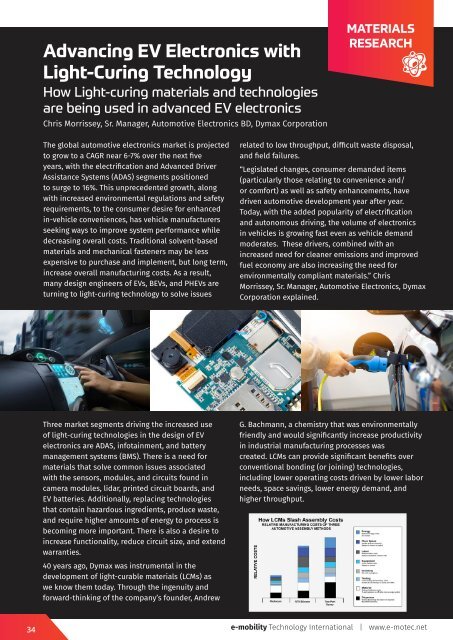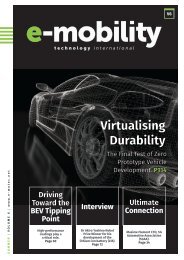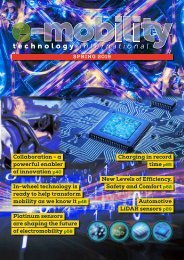E-mobility Technology Winter 2020
Electric vehicle technology news: Maintaining the flow of information for the e-mobility technology sector
Electric vehicle technology news: Maintaining the flow of information for the e-mobility technology sector
You also want an ePaper? Increase the reach of your titles
YUMPU automatically turns print PDFs into web optimized ePapers that Google loves.
Advancing EV Electronics with<br />
Light-Curing <strong>Technology</strong><br />
How Light-curing materials and technologies<br />
are being used in advanced EV electronics<br />
Chris Morrissey, Sr. Manager, Automotive Electronics BD, Dymax Corporation<br />
MATERIALS<br />
RESEARCH<br />
The global automotive electronics market is projected<br />
to grow to a CAGR near 6-7% over the next five<br />
years, with the electrification and Advanced Driver<br />
Assistance Systems (ADAS) segments positioned<br />
to surge to 16%. This unprecedented growth, along<br />
with increased environmental regulations and safety<br />
requirements, to the consumer desire for enhanced<br />
in-vehicle conveniences, has vehicle manufacturers<br />
seeking ways to improve system performance while<br />
decreasing overall costs. Traditional solvent-based<br />
materials and mechanical fasteners may be less<br />
expensive to purchase and implement, but long term,<br />
increase overall manufacturing costs. As a result,<br />
many design engineers of EVs, BEVs, and PHEVs are<br />
turning to light-curing technology to solve issues<br />
related to low throughput, difficult waste disposal,<br />
and field failures.<br />
“Legislated changes, consumer demanded items<br />
(particularly those relating to convenience and/<br />
or comfort) as well as safety enhancements, have<br />
driven automotive development year after year.<br />
Today, with the added popularity of electrification<br />
and autonomous driving, the volume of electronics<br />
in vehicles is growing fast even as vehicle demand<br />
moderates. These drivers, combined with an<br />
increased need for cleaner emissions and improved<br />
fuel economy are also increasing the need for<br />
environmentally compliant materials.” Chris<br />
Morrissey, Sr. Manager, Automotive Electronics, Dymax<br />
Corporation explained.<br />
Three market segments driving the increased use<br />
of light-curing technologies in the design of EV<br />
electronics are ADAS, infotainment, and battery<br />
management systems (BMS). There is a need for<br />
materials that solve common issues associated<br />
with the sensors, modules, and circuits found in<br />
camera modules, lidar, printed circuit boards, and<br />
EV batteries. Additionally, replacing technologies<br />
that contain hazardous ingredients, produce waste,<br />
and require higher amounts of energy to process is<br />
becoming more important. There is also a desire to<br />
increase functionality, reduce circuit size, and extend<br />
warranties.<br />
G. Bachmann, a chemistry that was environmentally<br />
friendly and would significantly increase productivity<br />
in industrial manufacturing processes was<br />
created. LCMs can provide significant benefits over<br />
conventional bonding (or joining) technologies,<br />
including lower operating costs driven by lower labor<br />
needs, space savings, lower energy demand, and<br />
higher throughput.<br />
40 years ago, Dymax was instrumental in the<br />
development of light-curable materials (LCMs) as<br />
we know them today. Through the ingenuity and<br />
forward-thinking of the company’s founder, Andrew<br />
34<br />
e-<strong>mobility</strong> <strong>Technology</strong> International | www.e-motec.net









